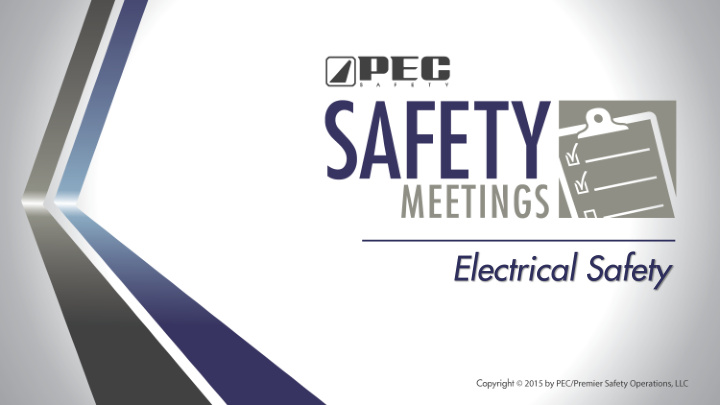



Electrical Safety
What is electricity ? • A form of energy that is carried through wires and is used to operate machines, lights, etc. PPT-SM-ES 2015 2
There are two forms of electricity… Static electricity Electricity that gathers in one place Current electricity Electricity that moves from one place to another PPT-SM-ES 2015 3
How does electricity work ? Electricity is the flow of electrons around a circuit Electrons carry electrical energy from one place to another, creating current electricity , or an electric current For an electric current to happen, there must be a circuit A closed path, or loop around which an electric current flows PPT-SM-ES 2015 4
How does electricity work ? Voltage • A kind of electrical force that makes electricity move through a wire • Measured in volts • The bigger the voltage, the more the current will tend to flow PPT-SM-ES 2015 5
How does electricity work ? Current • A steady flow of electrons, measured in amperes (or amps) PPT-SM-ES 2015 6
How does electricity work ? • Together, voltage and current give you electrical power • The bigger the voltage, the bigger the current and the more electrical power you have PPT-SM-ES 2015 7
How does electricity work ? Power is a measurement of how much energy you are using each second • Units of power X time, often converted into a standard unit called the kilowatt hour (kWh) PPT-SM-ES 2015 8
Why is electrical safety important ? Electrical incidents cause an average of 13 days away from work because of associated injuries and usually one fatality every day Always use caution when working near electricity PPT-SM-ES 2015 9
Workers are divided into two categories when working on or near energized equipment Qualified workers Unqualified workers have had training in have little or no training avoiding the electrical working on or near premises hazards of working on or wiring, wiring for connections to near exposed electrical supply electricity, installation of parts outside conductors, and optical fiber cables PPT-SM-ES 2015 10
What are the hazards of electricity and electrical equipment? Shock • Electrical arcs and blasts • Rescues • Ground faults • Extension cords • Broken or faulty equipment • PPT-SM-ES 2015 11
Occupations that put workers at risk of electric shock include • Electrical and electronic engineers, assemblers, and technicians • Electricians • Industrial machine operators • Mechanics and repairers • Painters • Riggers and roustabouts • Stationary engineers • Welders • And others PPT-SM-ES 2015 12
Protect yourself from electricity Follow specialized procedures in wet work areas Use lockout/tagout Conduct inspections Follow assured grounding programs Use GFCIs Guard energized parts PPT-SM-ES 2015 13
Wet Areas If you touch a live wire or other electrical component while • standing in even a small puddle of water , you will get shocked Avoid working in wet conditions • whenever possible Use approved electrical • equipment for wet conditions and do not stand in wet areas when operating electrical equipment PPT-SM-ES 2015 14
Lockout/Tagout Proper lockout/tagout procedures protect workers from the unexpected start-up of electrical equipment. These procedures make sure that electrical equipment is de-energized before it is repaired and protect workers against electric shock. PPT-SM-ES 2015 15
Inspections • Visually inspect all electrical equipment before use Remove any equipment with • frayed cords, missing ground prongs, cracked tool casings, etc., from service PPT-SM-ES 2015 16
Assured Grounding Program This includes a written program, daily visual inspections, and a method to detect a faulty grounding wire in an extension cord or hand tool. Grounding gives a stray current somewhere to go and keeps workers from becoming part of the circuit. Grounding symbol PPT-SM-ES 2015 17
What must be grounded ? All circuits and extension cords All noncurrent-carrying metal parts Portable and semi-portable tools and equipment unless they are double-insulated PPT-SM-ES 2015 18
Ground Fault Circuit Interrupters Used in wet locations, construction sites, • and other high-risk areas Interrupt the flow of electricity within as little • as 1 / 40 of a second to prevent electrocution Compare the amount of current going into • electric equipment with the amount of current returning from it along the circuit conductors If the difference exceeds 5 milliamps, the • device automatically shuts off the electric power PPT-SM-ES 2015 19
Guarding Locating or enclosing • electric equipment to make sure workers do not accidentally come into contact with its live parts Requires equipment with • exposed parts operating at 50 volts or more to be placed where it is accessible only to authorized workers qualified to work with it PPT-SM-ES 2015 20
Electrical Hand Tools Double-insulated Tool is encased in plastic, which • will prevent a worker from being electrocuted if the tool short circuits Identified with a square-within-a- • square logo or the words “double - insulated” on the label PPT-SM-ES 2015 21
There are many types of PPE specifically designed and approved for electrical work Rubber insulating gloves Matting Blankets Covers Line hoses Sleeves Type E hard hats FRC PPT-SM-ES 2015 22
Rescue If your coworker sustains an electrical injury, de-energize the circuit before getting help. Do not try to pull someone off of the electrical circuit. PPT-SM-ES 2015 23
PPT-SM-ES 2015 24
Recommend
More recommend